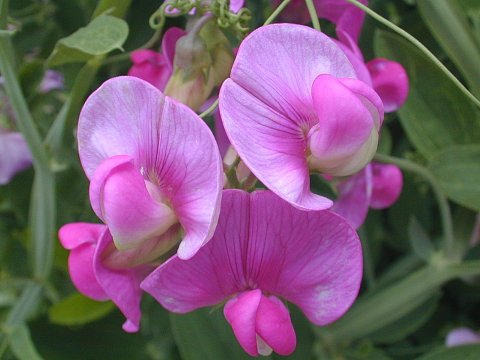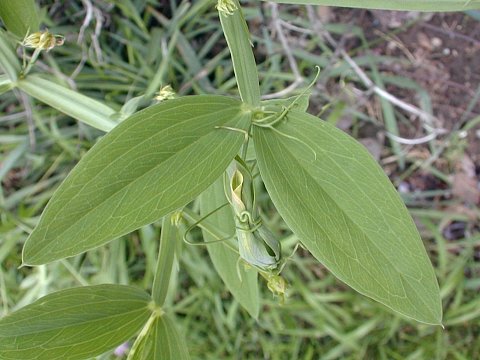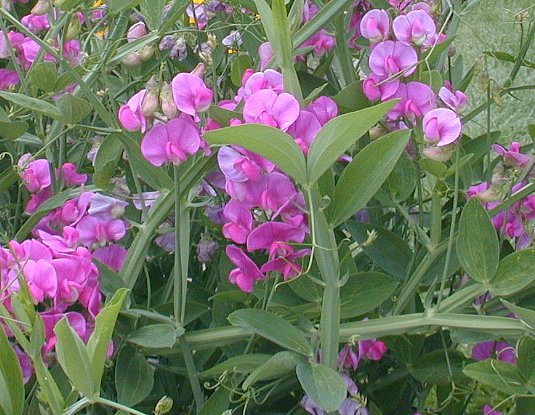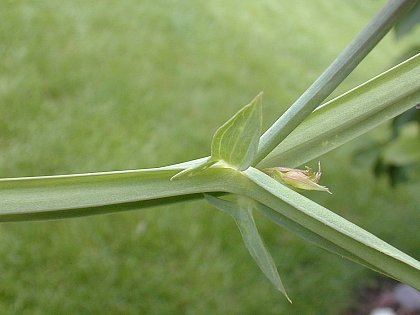Description: This herbaceous perennial vine is 3-6' long. It can climb adjacent vegetation or fencing by means of its twining tendrils, while in open areas it sprawls across the ground. The stems are hairless and strongly winged. Each alternate compound leaf consists of a single pair of leaflets and a winged petiole about 2" long. Between the leaflets is a branched tendril. The leaflets are up to 3" long and 1" across. They are narrowly ovate or oblong-ovate, smooth along the margins, and hairless.

Occasionally, short racemes of 4-10 flowers are produced from the axils of the leaves. Each flower is about ¾–1" across and has a typical pea-like structure, consisting of an upper standard and a lower keel that is enclosed by lateral petals. The 5 petals of this flower are purplish pink and become faded with age. The green calyx has 5 teeth that are often unequal in size. The blooming period occurs during the summer and lasts about 2 months. There is no floral scent. Each flower is replaced by a hairless flattened seedpod that is about 2" long and ½" wide, containing several seeds inside. The seedpod is initially green, but gradually turns brown, at which time it splits open into curled segments to fling the seeds. The dark seeds are oblong-reniform in shape. The root system consists of a taproot and rhizomes. This plant can spread vegetatively or by reseeding itself.

Cultivation:
Typical
growing conditions are full or partial sun and a loam or clay-loam soil
that is moist, mesic, or slightly dry. This plant is long-lived and can
slowly spread. By the end of summer, the foliage becomes ragged and
yellowish in appearance.
Range & Habitat:
The Everlasting Pea occurs occasionally in southern and central
Illinois, while in northern Illinois it is uncommon or absent (see Distribution
Map). It was introduced from Europe as a horticultural plant
because of the showy flowers. Habitats include meadows with history of
disturbance, woodland edges, sites of old homesteads, vacant lots,
fence rows, and gardens. Sometimes the seeds or rhizomes are
transported with soil by dump trucks into new areas. This species is
not an aggressive spreader, but it is competitive with other kinds of
vegetation and can persist for surprisingly long periods of time.

Faunal
Associations:
The flowers are pollinated by bumblebees. Butterflies occasionally suck
nectar from the flowers, but they are not effective at pollination. The
foliage of Lathyrus spp. (Wild Peas) is eaten by Epicauta
fabricii (Fabricius Blister Beetle) and the caterpillars of Grammia
oithona (Oithona Tiger Moth). The seeds are poisonous, while
the foliage is occasionally eaten by mammalian herbivores.
Photographic Location:
A flower garden along a fence row near Urbana, Illinois.

Comments: The flowers are showy and somewhat gaudy. The Everlasting Pea can be distinguished from many other Wild Peas by its winged stems and compound leaves with only 2 leaflets. In this this regard, it is similar to Lathyrus odoratus (Sweet Pea) and Lathyrus hirsutus (Singleton Pea). These latter two species are annual or biennial in their growth habit, rather than perennial. Both the Sweet Pea and Singleton Pea have racemes with 1-3 flowers, while the Everlasting Pea has racemes with 4-10 flowers. The flowers of Sweet Pea are usually fragrant, while the flowers of Singleton Pea are about ½" across. The flowers of the Everlasting Pea are about ¾–1" across and they are never fragrant.